Abstract
Hagia Sophia and Süleymaniye Mosque, built in the 6th and 16th centuries, respectively, are the two major monuments of the İstanbul World Heritage Site. Within the context of this study, sound fields of these two sacred multi-domed monumental structures are analyzed with a focus on their architectonic and material attributes and applied alterations in basic restoration works. A comprehensive study is undertaken by a comparative analysis over acoustical field tests held in different years and over an extensive literature review on their material and architectural characteristics. Initially, the major features of Hagia Sophia and Süleymaniye Mosque are presented, and later, basic alterations in regard to function and materials are provided. The methodology includes the field tests carried both within the scope of this research as well as the published test results by other researchers. Acoustical simulations are utilized for comparison of unoccupied versus occupied conditions and also for discussion on original materials. The impact of historical plasters on the acoustics of domed spaces is highlighted. Common room acoustics parameters as of reverberation time and clarity are utilized in comparisons. The formation of multi-slope sound energy decay is discussed in light of different spiritual and acoustical needs expected from such monumental sacred spaces.
1. Introduction
This research aims to investigate the effects of the main architectural features of monumental sacred structures on their interior sound fields. With their large volumes and multi-domed upper shell typology in the form of main dome spaces coupled to sub spaces sheltered either by domes or vaults, these historical structures have an outstanding and particular acoustical environment or so called “interior soundscape”. In architectural literature, domed structures are mostly observed in religious buildings. Sacred spaces have a specific role of emphasizing spirituality. Acoustics is one means of recognizing the indoor environment and a critical element to augment the divine character of sacred mega-structures. The basic architectural features of such monuments i.e., the central dome and huge volumes, result in the long and shallow reverberant decay, contributing to the key role of holy spaces.
1.1. Acoustics of Sacred Spaces
The literature on the acoustics of sacred spaces is extensive. Within this framework the acoustics of mosques [1,2,3,4,5,6], churches [7,8], basilicas [9] and cathedrals [10,11,12,13] have always been an attractive research topic for acousticians. In relation to this research there are mainly two groups of studies. The first group includes virtual re-construction of historical structures [2,3,11], renovation of pre-designed and built structures [1] for enhancing their indoor acoustical qualities, and acoustical design of new generation mosques [6]. The prominent methods in sound field analysis are field tests, scale modelling, and acoustical simulations [14]. The second group of studies focuses on non-exponential decay formation in multi-volume mega-structures [7,9,10,15]. The acoustical studies on sacred spaces search for the desired interior sound field in relation to function, which differs slightly in different religions. Worshippers sometimes need solitude, while at other times they want to feel in absolute unity with the others in attendance.
There are three basic acoustical requirements for mosques in relation to clarity as well as the spiritual effects of sound; audibility of the namaz—prayer orders of the Imam (prayer leader)—, recognizable sermon of the preacher, and listening to or joining in the recital of the musical versions of the Holy Quran. In mosques, in order to overcome the large sound attenuation of his voice over the rows of worshippers on the floor, the imam delivers his sermon at minbar and müezzin delivers the commands of namaz from müezzin′s mahfili. This scheme was specifically developed in the time of historical mosques when there was no electronic sound reinforcement. It was a positive effect that the sound source is above the receiver locations for providing more sound strength to the audience in mosques′ original schemes. In the acoustical design of mosques the male voice must be augmented by the architectural features of the space for the envelopment and spaciousness. Thus, the architecture must be incorporated within the expected formal language, which satisfies the spiritual aspects of a worship space. The common use of carpet as a floor finish in mosques instead of the stone floors prevalent in Christian spaces results in faster sound decay rates, thus shorter reverberation times. In Christian sacred spaces, intelligibility of sermons by a priest is one acoustical necessity [14]. On the other hand, recitals of liturgical music are much more frequent in churches and cathedrals when music as an activity is compared to those in mosques. For that reason, it is much more appropriate that the reverberation times are longer in churches or cathedrals when compared to those in mosques.
1.2. Room Acoustics Coupling in Multi-Domed Superstructures
Most od the time, the historical sacred spaces with multi-domed upper-structures have even longer reverberation times than classical venues for music. At this point, the basic challenge in the design of sacred spaces is optimizing reverberance. It is well-known that very high reverberation negatively affects speech intelligibility, while very short reverberation causes a dry acoustical environment that would reduce the envelopment and spaciousness in a religious space. These two contradictory requirements, clarity and reverberance, are hard to reconcile with classical decay properties of a single space room. Some previous studies highlight that multi-domed or vaulted monumental spaces are composed of multiple sub-spaces that are connected to each other with apertures in the form of arches. These arches behave as coupling apertures and depending upon the size of the apertures and as well as the volume of individual sub-spaces, a convex decay curve is observed in large cathedrals, basilicas [7,10,11], and in mosques [15]. Non-exponential or multiple sound energy decay with regard to the inherent properties of early and late decays can maintain the sense of intimacy and clarity that is mostly observed in coupled spaces. This outcome was further discussed in a previous study within a broader context of this research [16] and acoustical indicators in multi-domed superstructures were re-evaluated [17].
In order to contribute to the previous literature on acoustics of sacred structures, this study investigates two historically significant monuments of the İstanbul World Heritage Site. The first monument is Hagia Sophia, which was originally built in the 6th century and functioned as a church and later converted to a mosque, while currently serving as a museum. The second monument Süleymaniye Mosque is a 16th century structure. Their historical significance and religious uses in relation to acoustics have motivated many researchers to test and discuss characteristics of their interior sound fields. A comprehensive study is necessitated to assess the acoustical conditions of both structures in relation to their architectural features and interior finish materials and to examine the acoustical changes that have occurred due to the repairs undergone within their lifetime. Initially, the major architectural features of Hagia Sophia and Süleymaniye Mosque are presented, and later, basic alterations with regards to function and materials are provided. The methodology includes the field tests carried both within the scope of this research as well as the published field test results by other researchers. Acoustical simulations are applied for comparison of unoccupied versus occupied conditions, reflecting major activity patterns. The simulations also provide basis for a discussion on the acoustical outcomes of original or historical plasters versus the current condition after restorations. Finally, the formation of multi-slope sound energy decay in case structures is discussed briefly in light of different spiritual and acoustical needs expected from such monumental sacred spaces.
2. Hagia Sophia
Hagia Sophia, the Holy Wisdom of Christ, was constructed as a church between 532 and 537 in Constantinople (Istanbul) during the reign of the Byzantine Emperor Justinian. Hagia Sophia was both the center of religious life and had been a legend for the new wave of church buildings in the West in the 12th and 13th centuries. After the Ottoman conquest of 1453, during the rule of Mehmet II, it was converted from a church to a mosque. In 1932 upon order from Atatürk, Hagia Sophia (Figure 1) started to function as a museum. Hagia Sophia is a masterpiece of not only Byzantine art but also of the world’s historical heritage. Its architectural success and carried messages affected both the Ottoman Empire and architects such as Sinan the Architect [18,19,20,21].

Figure 1.
Hagia Sophia exterior view (www.ayasofyamuzesi.gov.tr).
The influences of Hagia Sophia′s form have revitalized many other domed spaces both in churches and mosques. On the other hand, the building physics aspects of the structure and materials has been a subject for many other researches [22]. The interior sound field of such an immense monumental building has also inspired acousticians. In some acoustical studies on Hagia Sophia, the room acoustical parameters were analyzed for its current condition, as further detailed in Section 5.1. By some other researchers, the acoustical history of the structure was virtually generated for different time periods and activity patterns [23]. One study focused on recreating Hagia Sophia′s acoustics within other venues by the use of electronic architecture [24].
Hagia Sophia is a large space with many coupled sub-spaces. High reverberance within such a large interior, lends unique properties to the music and demands suitable repertoire and singing ability in terms of liturgical music. The sound field of such a volume with dominating geometric and material attributes also inspired this study in terms of acoustical coupling investigations. In a broader framework, the non-exponential energy decay formation in Hagia Sophia for its current state was previously discussed [17].
2.1. Major Architectural Features
The major figure of Hagia Sophia is an expanded dome basilica: a rectangular building covered by a central dome between two half domes and integrating longitudinal and centralized planning (Figure 2). This structure has an interior length of 73.5 m and a width of 69.5 m, excluding the narthex and the apse. The length of the entire interior from the exonarthex to the edge of the apse is 92.3 m. The central nave is built on an east-west axis, and a large dome is constructed right in the center to cover up the space. The central dome that rises 55 m above the pavement of the nave is not exactly round but slightly elliptical today, with a diameter of 31.2 m on one axis and 32.8 m on the other [18]. The domed central space is skirted by two large hemicycles covered by half-domes to the east and west. The diameter of these half-domes roughly equals to that of the central dome. From the crown of each of the main piers and between the four great arches, the pendentives fan out on the interior and rise to a roughly circular projecting cornice [25,26]. The side aisles are separated from central nave by columns and arches sheltered with vaults. There are galleries over the side aisles and inner narthex, creating a U-shape that reinforces the centralizing tendency of this expanded dome basilica. The central oval vessel of enclosed space is further expanded by barrel-vaulted spaces that terminate along the building’s longitudinal axis at the east and the west ends of its nave [18]. Overall, Hagia Sophia has an approximate interior acoustical volume of 150,000 m³, which creates an outstanding visual and acoustical environment.
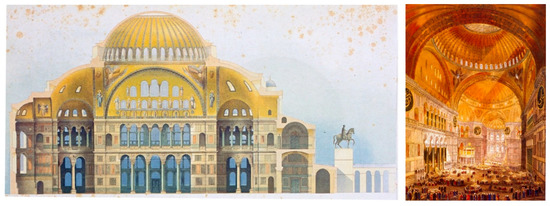
Figure 2.
On the left: section view of Hagia Sophia from the central axis by Salzenberg [25] (p.280), on the right: interior view—an old painting [25] (p.284).
Stone, brick and mortar are the main materials that compose the above-ground structure including the piers, columns, arches, vaults, and domes. The stone is either limestone or green stone—local granite. Above the springing level of the gallery vaults, most of the piers are built of brick. The surfaces of all the walls as well as the large supportive piers, bordered by sculptured moldings, are covered with polished slabs of veined marble and other colored stone. Internally most of the original marble revetment of the walls remains in place and most of the original non-figural mosaic decoration of the vaults has remained undamaged at ground level [18,20]. Some of the non-figural decorations in the galleries and above are distinguished partly by a much greater use of tesserae cut from natural stones and terracotta. All surviving figural mosaics are of a later date. The floor is paved today with large rectangular marble slabs, not the original one which was crushed in 1346 [20,26].
2.2. Basic Repairs and Alterations
Over the 1400 years of its existence, Hagia Sophia has suffered much damage essentially due to the major earthquakes. Three main phases of structural repair and strengthening are recorded. The first repairing phase was in 1317, in the reign of Andronicus Palaeologus; the second was in 1573 under the architect Sinan; and the third repair was in 1847 under the Swiss architect Gaspare Fossati, assisted by his brother Giuseppe. The principal work undertaken in 1317 was the construction of new buttresses. In 1573, Sinan built a new minaret in place of one that was to be demolished. In 1847 major works were the rectification of a number of columns in the gallery exedra, the installation of new ties for critical locations, and other repairment at the level of the dome base [20,21].
Hagia Sophia has also undergone many alterations due to the changes in its activity patterns. In conversion from a church to a mosque, some Christian elements were removed, and Islamic additions were introduced. Since pictorial representations are traditionally not permitted in Islam, after 1453 the mosaics were gradually covered up, whitewashed, or plastered over and hence preserved. After the Ottoman conquest, all the Christian furnishings were removed [20]. In 1847 the Sultan commissioned a pair of Swiss architects, Gaspare and Giuseppe Fossati, to restore both the fabric and the decoration of the building. During these works all the surviving mosaics were uncovered and copied in order to provide visual record. Unfortunately, many of the mosaics recorded by Fossati′s had disappeared by this date, most probably lost in the great earthquake of 1894. The original altar, screen, and ambo were badly damaged in the first collapse, and rebuilt in the subsequent restoration [18].
Among the Islamic additions, apart from four minarets on the exterior, a mihrab was added on the kiblah axis (the church is oriented to the east) The minbar was constructed in the same direction. Prayer carpets and banners of victory were hung on the walls during the mosque period. The Müezzin′s mahfili in the center of the structure and four more galleries in the narthex were added. On the left side of the central nave there is the preaching pulpit, that still exists. Imperial Pavilion and Imperial Loge (Figure 3) are some other additions which did not exist during the Christian period. Another significant addition of the Islamic period are the huge disks of inscriptions/calligraphies over wooden roundels with diameter of 7.6 m, which are acknowledged to be largest inscriptions in the entire Islamic world [26].
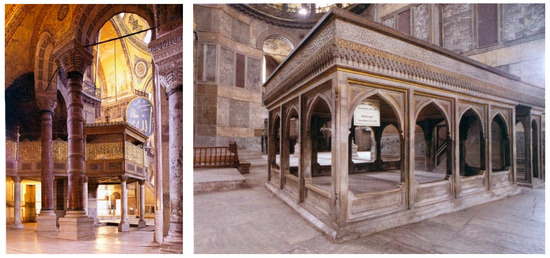
Figure 3.
On the left: imperial pavilion and loge, on the right: preaching pulpit [25] (p.176,179).
In 1932 upon order from Atatürk, Prof. Thomas Whittemore—founder of the Byzantine Institute of America—had been given the permission to uncover and clean the mosaics [19]. In 1992, a major restoration and consolidation of the mosaics in the dome was started by the Central Laboratory for Restoration and Conservation of Istanbul in collaboration with an international team of experts funded by UNESCO [18]. Not all listed here but many other Hagia Sophia restorations were held in its lifespan. Even today, the scaffoldings, which are used for the repairment of current mosaic damages at the central dome due to the water leakage and humidity, occupy a huge place within the nave of Hagia Sophia.
3. Süleymaniye Mosque
Being the largest of the Ottoman building enterprises of the time, Süleymaniye Mosque and Complex (Figure 4) was sponsored by Kanuni Sultan Süleyman in his ruling and designed by Sinan-the architect laureate of the Ottoman Empire-. The main construction was held between 1550 and 1557, while the whole structure with the fine works of tombs was completed in 1568 [27]. The complex is currently located in the historical island of Istanbul [28]. Süleymaniye Complex has a plan of three adjacent squares: the mosque itself, the courtyard with the last prayers section, and backyard, where the tombs of Sultan and his wife Hürrem are located. The site plan of the complex takes its references from the topography. The complex is composed of 22 different structures with different functions surrounding an interior courtyard [29,30,31]. Süleymaniye Mosque, which is the central figure of the whole complex, has always been an inspiration source for many fields including architectural aesthetics, structure and construction, acoustics, and material science. The acoustics of the mosque in this respect is an important subject of research.
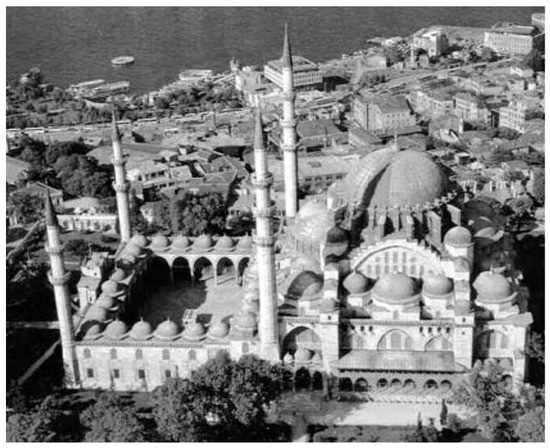
Figure 4.
Süleymaniye complex exterior view [28].
3.1. Major Architectural Features
Süleymaniye Mosque′s main structural elements are domes, arches, and flying buttresses. The mosque is covered centrally by a single dome which is supported on two sides by semi domes. The two semi domes align with the direction of the mihrab. Side aisles are sheltered by five smaller domes which complete the upper structure. Pendentives are utilized to smooth the central dome, secondary half dome, and arch connections. The inner plan of the mosque measures approximately 63 by 69 m. The main dome rests on four elephant feet and 32 footings on a circular wheel with a diameter of 26.2 m. The height from the foundation to the impost is 33.7 m. The inner rise of the dome is 14.0 m, and thus the height of the dome from the ground to the keystone is 47.8 m (Figure 5). The middle and corner smaller domes on aisles have diameters of 9.90 and 7.20 m [32,33]. Süleymaniye Mosque′s interior acoustical volume is approximately 75,000 m3.
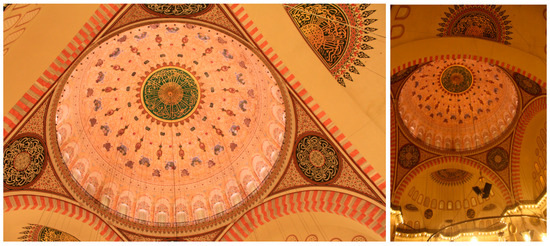
Figure 5.
Interior views of domes and pendentives in Süleymaniye Mosque (photos by the author).
The uniqueness of the building comes from abundant sources of stone supplies delivered from various ruins of ancient cities all over the world [34]. For its original state, other basic interior materials are plaster and paint on brick, tile, ceramic pots, glass, and wood. The interior walls are faced with stone revetments. The ceilings of the pulpits and the royal box, the domical superstructure, and the pendentives are painted (Figure 5). In contrast to lavishly painted domes and pendentives in lower zones the stone revetments left relatively bare. The prominent architectural features of the interior are historical columns, marble panels, porphyry discs, great arches, mihrab, minbar (pulpit) and royal box, stained glass windows, and inscriptions.
Limestone is the main structural stone as well as the facing stone for interior walls and wall footings. Piers carrying the main dome and suspension arches are of cut limestone while the inner faces are painted as of Hereke conglomerate and Proconnesian marble. Columns are of Egyptian porphyry (red sparrow eye). Different bricks were utilized as the core material of domes due to its lightness. Painted brick domes are then decorated with gold foiled pen paintings. The mihrab and the minbar are of carved white marble and have stained glass windows on the sides [35,36,37]. Lime, fine sand, gypsum, linen, and straw are the basic ingredients of plaster layers and seams. Linen is applied in dome plasters of Süleymaniye Mosque in its original state. Wood in the interior is mostly used for flat ceilings, doors, window frames and furniture. Only the two windows on each side of mihrab have kündekari wooden work shutters. The floor finish of the mosque is carpet with straw backing—which were collected from the finest straws grown in Nile delta—as stated in original documents. Carpets had originally been woven in Egypt and Aydın-Tire [35,36]. Another feature of Süleymaniye Mosque of its original state is the use of Sebu′s (clay pots), that are essentially applied to lessen the weight of the dome, but also believed to function as cavity resonators for the control of excessive low frequency sound (Figure 6).
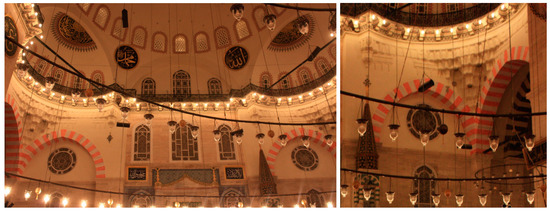
Figure 6.
Muqarnas details (photos by the author).
In accounting registers of Süleymaniye Mosque construction (account book number 108), it is declared that for plaster finish of dome (Beray-i sıva-i kubbeha-i cami′-i şerif) 134 kantar of linen was purchased [35]. This is significant information in terms of acoustical assessment of historical plasters that is detailed in following sections. As a final acoustical point, within the mosque muqarnas/stalactites are used as a transition element in column heads, in the skirting of half domes. These elements do not have any structural function and are out of gypsum. Muqarnas helps to enhance the sound diffusion in mostly curvilinear and concave transition planes by fragmenting these surfaces (Figure 6).
3.2. Basic Repairs and Restorations
Since the 16th century, Süleymaniye Mosque has not experienced any major structural or volumetric/spatial changes. Aside from some small extensions, the structure as a whole has kept its integrity and original form. However, there have been a couple of major interior material modifications. The initial restorations were held in 19th century successively in 1840, 1844, 1845, 1847, 1870, and 1873. In these interventions basically pen-carved paintings and plasters were modified, which ended up being substantially different—in terms of chemical and physical ingredients—interior finish characteristics. In the 1840s and 1880s restorations, held by Italian experts, it is recorded that the clay pots were covered and closed, and the original dome plasters were modified with gypsum plaster [36,37,38].
Since 1958, the restorations have been held within the control of T.R. Grand Commission of Memorial′. In 1959–1969 restorations basic interventions were the renewal of oil paints on elephant feet, removal of wooden cabinets at some locations, painting of door and window jambs, and renewal of dome and arch paintings. In these restorations, some of the 19th century paintings were removed in order to uncover the original paintings [38,39]. Prior to 2007–2011 restorations, on stone and wooden surfaces different types of material deteriorations were detected. In particular, the pen-paintings on dome facings and on ceilings of exterior side galleries were corroded due to moisture. Damage reported prior to 2007–2011 restorations also included structural damage, the damage due to cement-based plastering or seam fills, and damage due to some other inappropriate use of material [36,38]. The cement-based plasters and application of pen-wall paintings on these plasters are significant in assessing the changes in acoustical field of the Mosque. During 2011 restorations, the samples of original Horasan plasters in the dome were collected. Tests and analyses were held for obtaining cement free plasters that are compatible with original ones, then applied on renewed plastering and pen-wall paintings (nakış). The paintings within the Mosque took their final shape after 1957–1959 and 2007–2011 restorations [38]. Besides, it was also declared that the mouths of in total 256 clay pot (Sebu) voids were opened and cavities were repaired [40].
4. Methodology
4.1. Room Acoustics Measurements
In a broader scope of this study [16], acoustical field tests were held and results specifically in relation to multiple-decay formation were discussed previously for Hagia Sophia [17] and Süleymaniye Mosque [15,17]. This particular paper aims to discuss the findings in relation to different restorations together with acoustical measurements taken in different years by various research teams. As the impulse responses collected by other researchers are not available to this research for post-processing, results of T30 and C80, which are the common parameters available in all field tests, are presented in comparative analysis.
Field tests, within this study′s scope, were held in Süleymaniye Mosque on 23 February 2013, in between the hours of 19:30 p.m. and 3:00 a.m. at the main prayer hall, and in Hagia Sophia on 25 August 2014, in between the hours of 09.00 a.m. and 12.00 a.m. at the ground floor, for both in unoccupied conditions [17]. In assessing room acoustic parameters, field measurements were held in accordance with ISO 3382-1,2009 [41]. B&K (Type 4292-L) standard dodecahedron omni-power sound source was used in acoustical signal generation with B&K (Type 2734-A,) power amplifier. The impulse responses at various measurement points were captured by B&K (Type 4190ZC-0032) microphone, incorporated into the hand held analyzer (B&K-Type 2250-A). Sampling frequency of the recorded multi-spectrum impulse was 48 kHz, covering the interval of interest between 100 and 8000 Hz. DIRAC Room Acoustics Software Type 7841 v.4.1 was used for both generating different noise signals and for post-processing of the measured impulse response data for each receiver position. For reliable decay parameter estimations, it was aimed to obtain signal that was at least 45–50 dB higher than the noise in all octaves. Tested signals were E-sweep, MLS, MLS-pink, balloon pop, and wood clap. Up to five pre-averages were applied over multiple measurements, with impulse response length of 21.8 s. E-sweep provided the highest PNR values, thus those samples were mostly utilized in post-processing. As an example, comparison of some sample source signals is provided in Figure 7.
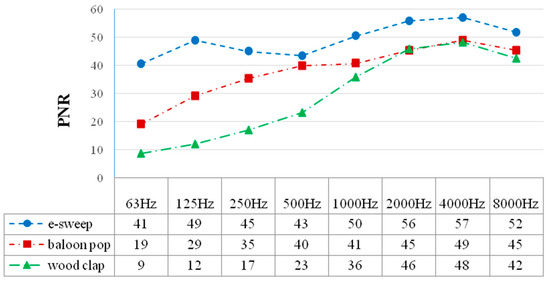
Figure 7.
Hagia Sophia PNR measurements in 1/1 octave bands in Hz; comparison of e-sweep, balloon pop, and wood clap source signals.
The measurement positions of field tests are represented in Figure 8, in which the sizes of each structure in relation to one another can also be compared on the plan scheme. Major source locations in Süleymaniye Mosque are one in front of mihrab (S1) and the other at müezzin mahfili (S3). The positioning of sound source is important to assess the acoustics of Süleymaniye Mosque for its traditional use. For acoustical coupling or multi-decay rate investigation, additional source locations including one underneath the main dome (S4) and one underneath side corner dome (S2) were tested [42]. Eight receiver locations (R1–R8) were coupled with four source locations (S1–S4) providing measured source–receiver configurations. In order to observe multi-slope decay formation for different locations and to discuss the effects of spatial variations—such as main central space versus space underneath side galleries—in Hagia Sophia, three source (S1–S3) and six receiver (R1–R6) positions were tested in numerous configurations (Figure 8).
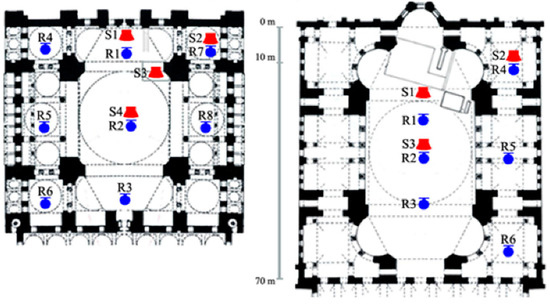
Figure 8.
Sound source (in red) and receiver (in blue) locations used in field tests of Süleymaniye Mosque—METU-2013 tests (on the left) and Hagia Sophia—METU-2014 tests (on the right).
Other measurements following different restoration periods are also summarized in this section. The first set of measurement in Süleymaniye Mosque was held after 1959–1969 restorations by Gazi University [43] in 1988 (GU-1988); the measurements were taken in 1/3 octaves for the frequency spectrum in between 100 and 8 kHz. The following field tests were taken by Middle East Technical University (METU) in 1996 (METU-1996); broadband noise signal was emitted at two source locations including one in front of mihrab and one over müezzin′s mahfili. Impulse responses were collected for six receiver locations at the prayer′s area [44]. The final group of measurements after 1959–1969 restorations, as can be found in the academic literature, were held in 2000 within the scope of Conservation of the Acoustical Heritage by the Revival and Identification of the Sinan′s Mosques CAHRISMA project [3]. Ferrara University (UNIFE-2000) and Denmark Technical University (DTU-2000) held two different measurements within that scope. Sweep signal was used as a source signal, and impulse responses were collected for different configurations of three source and six receiver locations. UNIFE used test signal possessing of the 80–18,000 Hz spectrum range and DTU used test signal possessing of the 35–11,500 Hz spectrum range. DTU recorded impulses for 10 s of capture length [3]. The first measurements after 1959–1969 restorations were held within the context of this thesis research [16] and abbreviated as METU-2013 in following discussion for the ease of comparisons.
Following the major alterations due to the functional changes, the basic restoration and consolidation of the mosaics in the dome of Hagia Sophia started in 1992, as previously summarized. There is no available measured acoustic data in the literature before that period. All of the available field data of Hagia Sophia were collected after 2000. Previous to Hagia Sophia measurements held in the scope of this research [16] in 2014 (METU-2014), two other set of data were recorded. Ferrara University (UNIFE-2000) and Denmark Technical University (DTU-2000) held two different measurements in the context of the CAHRISMA [3] project in 2000, similar to those explained for the Süleymaniye Mosque.
4.2. Acoustical Simulations
The acoustical simulations of historical structures are carried out in a broader frame of this research by two main methods that are ray-tracing simulations and diffusion equation model (DEM) analysis in a finite element scheme. For applying different estimation methods, the acoustical models of both structures were generated, utilizing the latest building survey registers (röleve) for Hagia Sophia provided by the Turkish Ministry of Culture and Tourism—General Directorate of Turkish Cultural Heritage—and for Süleymaniye Mosque provided by the General Directorate of Pious Foundations. For highlighting the different volumetric relations and major form of the encapsulated interior sound fields, in Figure 9 the ray-tracing models of both structures are presented.
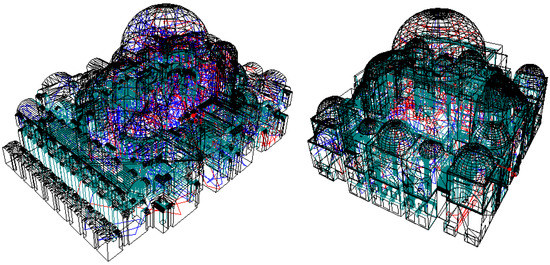
Figure 9.
Ray tracing models of Hagia Sophia (on the left) and Süleymaniye Mosque (on the right).
Ray tracing simulations were carried out by ODEON Room Acoustics Software v.14.00 (Odeon A/S, Lyngby, Denmark) [45]. For field tests there were limited time within permitted dates, due to the historical and touristic significance of both structures. For that reason, before field tests, ray-tracing simulations were held for obtaining a general overview regarding to multi-slope decay formation for most probable positions. After field tests, the models were tuned and further utilized for experimentation of different materials of the original state and fully-occupied conditions. The DEM method was utilized for in depth-analysis and understanding of the probable reasons of multi-slope decay formation in such multi-domed monumental structures by energy flow vector, energy flow decay, and spatial sound energy distribution analysis and results are presented in previous papers [15,46,47].
In this study, main objective was to discuss the acoustics timeline of the case structures. For briefness, only the Süleymaniye Mosque′s ray-tracing simulation results are presented for different materials and occupancy states to represent its original condition. The source and receiver positions applied in simulations are identical to those used in field tests. Yet again, similar to the field tests, omni-power sound sources are utilized in simulations. Materials are defined with associated sound absorption and scattering coefficients of the interior surfaces by tuning the model with the present field test results (Table 1). Later, the full occupancy of the Mosque during a Friday’s sermon is estimated and compared to its unoccupied condition.

Table 1.
Sound absorption coefficient and scattering data of applied materials in acoustical simulations.
The sound absorption coefficient data for standard materials as of single layer gypsum, marble on concrete, stone cladding, large pane or multi-layer glass surfaces are well defined in various sources that are more or less identical and mostly reflective as well. The critical issue in this case is assignment of comparatively absorptive materials to those listed in the former. The absorptive materials can significantly change the sound energy decay rates within such immense volumes depending upon their applied surface areas. For the optimization of sound absorption coefficients of current carpet two different sources were visited. Among those, one sample was tested under the scope of the CAHRISMA project [3] and the other is a previously tested carpet sample [50], which is widely used in Turkish Mosques. The sound absorption coefficient data of people on the prayer area applied in simulations—reflecting occupied state of the mosque—are taken from previous laboratory tests of mosque congregations [48]. The attained scattering coefficients on different surfaces are based on the amount of surface irregularities, in small or large scale. In the calibration process of acoustical models, field test data were utilized and T30 values were compared to simulations for different receiver locations. Just noticeable difference (JND) for T30 was kept under 5%, when simulated results were tuned to measured ones. Basically, the unknown sound absorption performances of plasters applied today -and modified in previous restorations-, has given direction to the tuning.
The original acoustical features of the Mosque were examined based on an assumption that the interiors, before restorations, were lime-based plasters with pozzolanic additives which are compatible with the historical ones belonging to the same era. Specifically, the sound absorption coefficients of interior plasters in current state were estimated to be in the range of 0.05 to 0.07 for the mid frequency range, while the sound absorption coefficients of the historical lime-based plasters were previously documented to be in between 0.20 to 0.30 in the mid frequency range [49]. Such a simulation analysis is expected to offer an insight into the probable acoustical conditions in respect to historical lime-based plasters versus today’s repair plasters, as discussed in Section 5.3.
5. Results and Discussion
5.1. Acoustics of Hagia Sophia after the 1990s
The data presented for METU-2014 measurements were initially collected for different source signals including wood claps and popping of a balloon. Hagia Sophia was too large to be excited with either a balloon pop or wood clap, and measurements did not provide the sufficient signal (or peak) to noise ratio in the overall frequency spectrum, while neither of those source signals were perfectly omni-directional (Figure 7). Among MLS and e-sweep excitations, e-sweep provided the highest peak-to-noise (PNR) values ranging in between 45 to 60 in the overall spectrum, which were found more reliable to be used especially in multi-slope investigations. For that reason, in Figure 10 and Figure 11 only the e-sweep generated impulse response results are presented for METU-2014 tests.
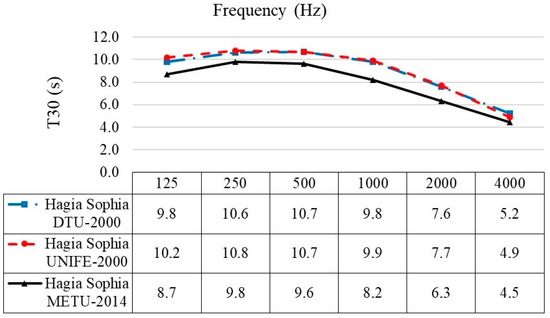
Figure 10.
Comparison of T30 results over collected impulse responses in Hagia Sophia by Denmark Technical University (DTU)-2000, Ferrara University (UNIFE)-2000, and METU-2014 in field tests, in 1/1 octave bands from 125 to 4000 Hz.

Figure 11.
Comparison of C80 results over collected impulse responses in Hagia Sophia by DTU-2000, UNIFE-2000, and METU-2014 in field tests, in 1/1 octave bands from 125 to 4000 Hz.
In Figure 10, DTU and UNIFE indicate measurements taken in 2000 under the supervision of the CAHRISMA project [3]. Hagia Sophia field tests held in 2000, highlight that T30 values in overall are higher than field test results of METU-2014 measurements. The drop of T30 values in METU-2014 measurements below 250 Hz in Hagia Sophia could be the result of the barrier wall separating one side aisle from main volume over the whole longitudinal length, which was present within the space during field tests due to ongoing restorations. Out of single layer gypsum board connected to back studs/profiles in certain intervals, it is probable that the system behaved as an effective low frequency membrane absorber. As another outcome, the mid to high frequency drop in T30 values of METU-2014 measurements in comparison to pre-2000 restorations are one probable result of present scaffolding in on-going restorations that were re-built after 2012. Thus, the presence of additional architectural elements/constructions within the space during METU-2014 measurements resulted in a drop of 1 to 2 s, in the overall frequency spectrum, of reverberation times. On the other hand, the trend of the sound decay over the frequency spectrum is similar for all Hagia Sophia field tests.
C80 is a parameter that is very much dependent on source-receiver positions. Therefore, the deviations in average values of different field test data is expected. It is well known that, subjectively, clarity is the hearing or sensation of individual pieces within music or speech. In objective terms, clarity is the ratio of early to late energy and it is a competing or reverse parameter to the reverberation. Thus, the trend of C80 values for overall field tests is in the opposite manner of T30 results.
It is known that there were no major architectural or form modifications between 2000 and 2014 in Hagia Sophia restorations. Field recorded data is not available for before 1992 restorations, when the consolidation of the mosaics in the dome started. Thus, it is not possible to compare the basic alterations of Hagia Sophia, especially in regard to changes in its function, and to discuss on the success of cleaning of the mosaics, and their acoustical results through field tests.
Overall, in the current state of Hagia Sophia, the T30 results obtained in recent years by different research groups indicate very high reverberation times within the mega-structure. Mid and low frequency T30 averages are around 9 s and high frequency averages are around 5 s. This superb and extraordinary aural environment is unique and has the potential to provide acoustical field conditions in relation to coupled spaces for specific locations. Non-exponential sound energy decay is one outcome of Hagia Sophia′s architectonic language, a brief discussion of which is presented in Section 5.4.
5.2. Acoustics of Süleymaniye Mosque for before and after 2007–2011 Restorations
The architectural and material modifications on Süleymaniye Mosque in different time periods are briefed in Section 3.2. With an aim of assessing the acoustical effects of previous restoration works, the field measurements taken in 2013 (METU-2013) are compared with previous field test data. The common acoustical parameter measured and assessed in all field tests for Süleymaniye Mosque is the reverberation time (T30). Thus, measured T30 values over octave bands are the basis of comparisons (Figure 12). Some previous literature recommends reverberation times of 4-4,6 s for mid frequencies as an optimum range for mosques with similar volume [3]. According to Figure 12, all of the field tests indicate very long reverberation times, higher than recommended ranges for the mosques for unoccupied condition. Especially, 125 Hz is very problematic considering the intelligibility of speech; which will be even worse when the electro-acoustic system is on, as in today′s applications. The T30 values over 2000 Hz are comparatively more suitable for the Mosque′s function in comparison to mid to low frequencies. The main reason of this drop in higher bands is the absorption of air of such an immense volume.
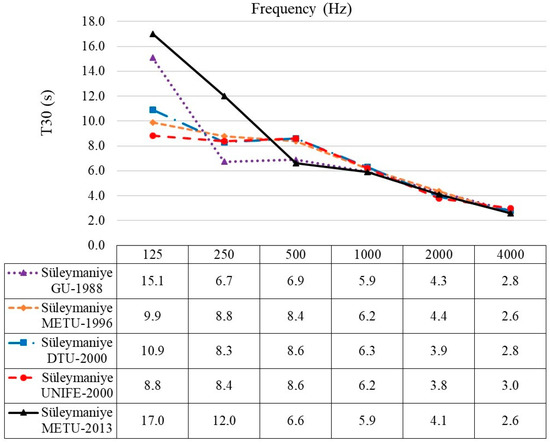
Figure 12.
Comparison of T30 results over collected impulse responses in Süleymaniye Mosque by Gazi University (GU)-1988, METU-1996, DTU-2000, UNIFE-2000, METU-2013, and AU-2013 in field tests, in 1/1 octave bands from 125 to 4000 Hz.
In METU-2013 measurements below 100 Hz, reverberation times reaching 20 s are observed. It is also noted that there are some measurement spots reaching 20 s at 125 Hz in GU-1988 measurements that are excluded from the average as considered to be the highest deviation [43]. The rise in 250 Hz of METU-2013 measurements are due to the very high values of T30 at 200 Hz in the 1/3 octave band. One reason for the deviations among different measurements might also be due to the averaging of 1/3 octaves or only plotting 1/1 octaves. In 1996 and 2000 field tests, T30 values at 125 Hz were measured in between 9 and 11 s, which are much lower than 1988 and 2013 measurements. This result is most probably caused by the insufficient capture/impulse response lengths of the other field tests. For instance, the DTU-2000 measurement set-up uses 10 s of impulse response length, in the real case, which could easily have missed the chance of estimating a longer reverberation time. On the contrary, both of the first measurements taken by GU-1988 with analogue equipment and the final measurements taken by METU-2013 with digital equipment and with an impulse length of 22 s, indicate 15–17 s of T30 values at 125 Hz. Thus, it could be stated that 2007–2011 renovations have not significantly affected the T30 values at 125 Hz, which are still very high and above the acceptable limits for mosque function.
According to METU-2013 measurements, reverberation times for octave bands in between 500 and 4000 Hz have been lowered by different ratios compared to previous years′ test results. The major change is the 2 s of drop at 500 Hz. When T30 values at 250 and 500 Hz are compared for 1988 measurements and 1996–2000 measurements, an increase of 1.5 to 2 s is observed in the latter. In order to be able to explain this increase, the probable undocumented minor-restorations or material changes in between the years of 1988 and 1996 should be known. Another point is that the measurement positions vary in different field tests, so only average values could be compared.
The comparative analysis of field test results indicate that the 2007–2011 restorations resulted in a slightly positive decrease in reverberation time at 500 Hz, whereas overall, the values are still higher than the recommended ranges. The attempts for removing cement-based plasters, and application of plasters that are compatible with historical lime-based plasters, as so declared, are constructive but not yet efficient acoustical interventions; especially in control of low frequency sound content. The effects of so stated intrusion on Sebu (clay pot) voids—opening the mouths and repair of inside cracks—are still vague in acoustical terms. In order to be able to scientifically comment on acoustical effects of Sebu repairs, the present geometrical and dimensional properties of these elements should be identified, which can only be possible by their systematic inspection on site.
Reverberation time (RT, T30, T20) is one of the key parameters affecting intelligibility of speech. Another important acoustical parameter that affects intelligibility is the level of background noise. High background noise can mask the speech subjectively and can drastically lower the speech transmission index (STI) values. Background noise is a frequency dependent parameter, so its spectrum differs for different noise sources. METU-2013 measurements were taken at night, when the Mosque is closed for visit or prayer and intriguing environmental/traffic noise was at minimum. The measured background noise level was LAeq 39.3 dBA, which is higher than the recommended—NC5 (35 dBA)—upper limit of background noise levels for religious spaces [51]. The high background noise levels detected are caused by the cooling fan units of electrical panels located within the Mosque at the first level right across the mihrab wall. It is evident that one of the basic reasons behind the claims for acoustical or intelligibility problems within Süleymaniye Mosque after the final restorations is the presence of fan noise, which can easily distract speech related activities such as hutbe′s by imam.
5.3. Interpretation of Süleymaniye Mosque′s Acoustics for Its Original State
Süleymaniye Mosque has gone through various restorations in years, and the acoustical conditions within the Mosque after specific restorations are compared and assessed in previous sections by the data out of field tests. However, none of the field test results reflect the acoustical conditions of the Mosque in its original state. On the other hand, the acoustical expectations from the Mosque in the years of its construction and expectations from a mosque in these contemporary years are quite different. All of the historical mosques today incorporate the use of sound-reinforcement systems. For historical mosques, which were designed for natural sound in their time, it is evident that problems would occur in application of electro-acoustic systems unless necessary precautions are taken.
One of the basic architectural parameters in room acoustics affecting natural speech/sound are the volume of the main space and its geometry. It is known that the dimensions and basic geometrical features of Süleymaniye Mosque have not been altered to date. The dominating form of the Mosque is the central dome which is supported by two semi-side domes. Acoustical focusing effects of the dome can be prevented to some extent, in the case that the lower end of the diameter/circumference of the dome section is located much higher than the receiver/prayer ear height [6]. In Süleymaniye Mosque, even the focusing zone of the biggest central dome is located 20 m above the prayer plane/floor. By the help of this, the first order reflections might have been minimized. However, the dome form causes sound foci at its focal points and negatively affects the sound scattering.
Sinan the Architect in his mosques applied the Sebu (clay pot) technique, which may have enabled acoustical asymmetry within the dome by scattering the sound and enlarging the dome reflection zone. By that, much even distribution of sound within the prayer zone could be provided. Sebu forms are similar to that of amphoras, which have a short neck and a backing volume. The Sebu technique in the structure enables to lessen the weight of the dome, while in acoustics they can easily function as Helmholtz resonators. These elements can scatter sound. Especially at low frequencies (63–250 Hz) they can behave as narrow band volume absorbers. In the account books (D.88. Yp. 19/a) of Süleymaniye Mosque′s construction work, it is recorded that each for 2 akçe′s (the chief monetary unit of the Ottoman Empire, a silver coin) total of 255 “Sebu” were purchased [35]. Several investigations state that 64 of these pots are located on a circular disk at the central dome [43]. On the other hand, after 2007–2011 restorations it was declared that 256 pots open towards the interior space were detected [40]. According to these declarations, the numerous applications of these clay pots (Sebu′s) with various sizes could widen the frequency bandwidth that they are effective in. Thus, it could be predicted that such an application in the original state of the Mosque, to some extent, had healed the excessive low frequency sound content. Together with Sebu voids, the fragmentation of parallel surfaces in both sections and plan schemes of the Mosque by architectural elements such as mahfil′s, niche′s, and surface treatments such as muqarnas, kündekari, and glazed ceramics have provided sound scattering in a wide frequency spectrum, so that an even distribution of sound throughout the prayer zone is obtained.
In spaces with excessive volume as in Süleymaniye Mosque, the expected long reverberation times have to be controlled by increasing the sound absorptive surface area. For an even distribution of reverberation over frequency, the sound absorption of materials in octave bands should be well balanced. Carpet is an absorptive material for mid and high frequency range only, unless it has at least 5–10 cm height platform, or air space, underneath. In the records of construction documents of Süleymaniye Mosque such a platform is not mentioned [35]. This means that the original carpet′s sound absorption performance would be similar to that of today′s carpet for low frequencies, and not much of a difference is expected from high frequencies in reference to some other research on carpet effects′ in mosques [50]. One other significant piece of information is that in its original state, straw is laid underneath carpet of Süleymaniye Mosque [35], which would have provided a slight improvement in absorption of mid frequency sound content. Carpet is still significant in terms of providing positive absorption area for intelligibility (of consonants). Apart from those, in a prayer scenario the presence of people and their compactness improve sound absorption as well as scattering within the Mosque, as observed in full-occupancy simulation results (Figure 13).
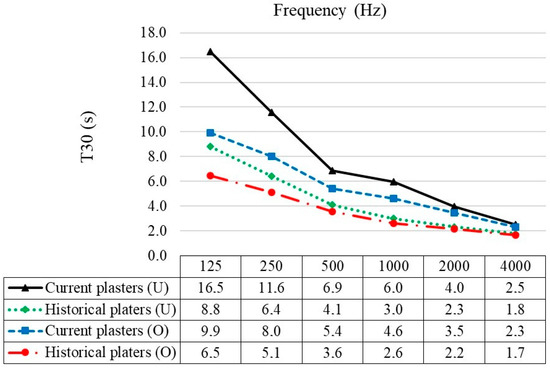
Figure 13.
Simulated T30 results of Süleymaniye Mosque Hz in 1/1 octave bands from 125 to 4000 Hz for its current state and trial with historical plasters for unoccupied (U) and unoccupied (O) conditions.
The absorptive carpet floor surface is still not sufficient to tolerate the long reverberations of this immense volume. On the other side, in Süleymaniye Mosque shiny and tight stone walls, column, and elephant feet surfaces compose the reflective areas. The sound absorption coefficients of applied stones within Süleymaniye Mosque can be predicted for the current and original states in the range of 0.05–0.10. The unknown is the sound absorption coefficient data of original/historical plasters with or without paintings that are renewed in several restorations. These plasters are applied at dome, arch, and mostly upper wall surfaces, and compose a very large surface area of approximately 19,000 m2. The influence of these plasters on reverberation times would be noteworthy [52].
In the account books (D.108) of Süleymaniye Mosque′s construction work [35], it is recorded that 134 scale linen were purchased to be used in plastering of dome. In some other account books, it is also recorded that 524 kantars (Ottoman weight unit corresponding to 56.5 g) of linen were purchased for plastering of the structure in general. Use of linen within the composition of interior surface plasters in Süleymaniye Mosque is an important acoustical element. Linen is commonly used to improve the tensile strength of mortar and/or plaster materials; on the other hand, in acoustical terms it can also increase the sound absorption performance of the plaster at low frequency range. Linen can also augment the mechanical strength of plasters [53,54]. It can be predicted that by the use of linen Sinan the Architect increased sound absorption area serviced by plastered surfaces, which then provided a more controlled reverberation within the mosque in both low and mid frequencies.
Another significant point is that the previous literature highlights the acoustical significance of porous and soft horasan mortar with linen and hemp fiber ingredients that are applied on dome and wall surfaces in Sinan′s mosques [43]. The replacement of historical mortar and plaster, which are good absorbers at low to mid frequency range, with tight and stiff cement-based plasters in specific restorations are accused of causing excessive reverberation times observed especially at low to mid frequencies at most of the historical mosques. The use of natural fibers as an ingredient in historical plasters, in fact, is considered to be significant information in terms of acoustical performance of historical plasters, and needs to be investigated with further studies.
In another study, the historical Turkish Baths of the same era were investigated in terms of the acoustical performances of plasters applied in their interior wall surfaces. The sound absorption coefficients of historical multi-layered pozzolanic lime plasters were tested by the impedance tube method [49]. According to that, historical Turkish Bath plasters have sound absorption coefficients of (α) 0.25–0.30 in the mid frequency range and (α) of 0.10–0.17 in the low frequency range, which are higher than the current plasters estimated to have (α) of 0.03–0.09 in the mid frequency range. In Süleymaniye Mosque the current plastered surfaces cover a significant area that should have a drastic impact on effective sound absorption within the Mosque.
For testing the above argument, the acoustical model of Süleymaniye Mosque (Figure 9) was utilized in a simulation study that compares today′s plasters, after multiple restorations, with historical multi-layered pozzolanic lime-based plasters. The procedure of model tuning for current state with field tests are presented in Section 4.2. The results are initially attained for unoccupied condition as in field tests, later the results are obtained for occupied condition. The simulations are done for both current state of the Mosque and for modified acoustical model with historical plaster data [49]. Occupied condition represents the full-occupancy as in Friday′s Sermon when clarity of speech is more important.
The plot of the simulations tuned by the acoustical field tests in Süleymaniye Mosque′s current condition is quoted as “Current plasters (U)” in Figure 13. The measurement results used in this tuning are given in Figure 12 indicated by “Süleymaniye METU-2013.” According to the simulation results for unoccupied condition, the replacement of cement-based repair plasters with historical ones ended up with a drop of 2.8 s in T30 value at 500 Hz and almost a drop of 8 s at 125 Hz (Figure 13). T30 values for the fully-occupied mosque in its current state is 6.6 s lower than that of its unoccupied condition for 125 Hz, and 3.6 s lower than unoccupied condition for 250 Hz. However, the low frequency reverberation times are very high and distracting for intelligibility in its current state. This situation causes even worse acoustical defects, in fact, when the electro-acoustic system is on. In the fully-occupied state of the Mosque with the application of representative historical plasters, the reverberation times are lowered by 2 to 3 s in mid and low frequencies in comparison to the same occupancy state with current plasters. The reverberation time values in between 5 and 6.5 s in the low octaves and 2.6–3.6 s in the mid frequency range indicate that with this trial of historical plasters, Süleymaniye Mosque′s interior sound field is much suitable and closer to the recommend limits for mosques with similar volume [3,55]. Although there were some recent attempts in removing cement-based plasters (2007–2011 restorations), the 2013 field measurements show that the problems are not thoroughly solved. Results indicate that if the historical plasters could have survived till now or if the Mosque underwent repairs with the plasters totally compatible with the historical ones, the acoustical conditions would be much more suitable for the function of a mosque today, as well.
As a final note, being located in a courtyard of a big complex (külliye) surrounded by walls together with a thick masonry wall construction—widths ranging in between 65 and 200 cm—and strong exterior shell of domes [29], Süleymaniye Mosque was very well isolated from any environmental noise that might be present in its time. Vehicle traffic, industrial noise, or mechanical equipment noise, as in today′s, did not exist in the past. Thus, the intelligibility of speech within the Mosque, had been at least masked, or distorted, in its original state.
5.4. Interior Sound Fields of Hagia Sophia and Süleymaniye Mosque in Relation to Major Architectural Parameters
The aim of this section is initially to assess the dissimilar sound field of Hagia Sophia in comparison to Süleymaniye Mosque, due to volumetric, geometric, and material input. The joint interpretation of results over data obtained at field measurements in 2013 (or METU-2013) for Süleymaniye Mosque and in 2014 (or METU-2014) for Hagia Sophia are presented. The results are provided for T30 in Figure 14 and for C80 in Figure 15, over octave bands from 125 to 4000 Hz and with average, maximum, and minimum values for overall source-receiver positions (Figure 8). As can be observed from Figure 14, the deviation in between measured receiver positions are mostly less than 1 s, and reach up to 2 s in a few octave bands. It is evident that when different receiver positions are compared over minimum and maximum values, the difference is noticeable due to the immense volume. However, the discussion on subjective response evaluation should not rely on single decay metrics but rather be considered under the view of multi-slope sound energy decay formation.
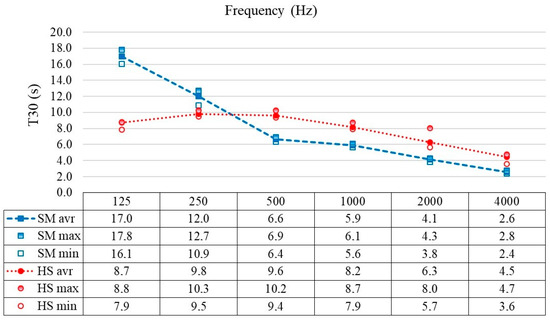
Figure 14.
Comparison of T30 results over collected impulse responses in field tests of Süleymaniye Mosque by METU-2013 and in Hagia Sophia by METU-2014, in 1/1 octave bands from 125 to 4000 Hz.

Figure 15.
Comparison of C80 results over collected impulse responses in field tests of Süleymaniye Mosque by METU-2013 and in Hagia Sophia by METU-2014, in 1/1 octave bands from 125 to 4000 Hz.
Due to volumetric differences, dimensional proportions and variable sound absorption characteristics of interior finish materials Süleymaniye Mosque have expectedly lower reverberation times in the frequency range over 250 Hz in comparison to Hagia Sophia. This result was expected considering the doubling of acoustical volumes, which is roughly around 75,000 m3 for Süleymaniye Mosque, whereas roughly around 150,000 m3 for Hagia Sophia. The plan schemes of two structures are compared in Figure 8, indicating the considerable differences in size, even in plan layout. Another significant aspect in relation to reverberation, aside from the interior volumes, is the interior finish materials. Marble floor surface in Hagia Sophia in comparison to the carpet floor finish in Süleymaniye Mosque is also very much effective in the increase of reverberation times, specifically over mid to high frequencies. Whereas, the carpet is not that effective under 250 Hz, and this time the reverberation is higher in Süleymaniye Mosque.
In Süleymaniye Mosque, T30 values at 125 Hz are observed to rise to very high levels, which are even much longer than T30 values obtained at 125 Hz in Hagia Sophia. That indicates a probable occurrence of resonances within the main space of Süleymaniye Mosque within that particular frequency band interval. Overall, the distribution of reverberation times over source-receiver positions are smooth and there are no big differences between the average and minimum-maximum values. This indicates a reasonably even distribution within both structures with such great volumes. The diffuseness is due to the surface fragmentations provided by efficient scattering of sound by means of arches, muqarnases or stalactites and mahfili′s. It should also be noted that high reverberance inside Hagia Sophia provides suitable repertoire and singing ability in terms of liturgical music, while in Süleymaniye Mosque music is not practiced that much, but only ritual sermons. Thus, the interior sound field of Süleymaniye as a mosque and Hagia Sophia as a church are practically much more suitable for their authentic function of use.
As shown in Figure 15, the average trend of C80 values over frequency spectrum obtained for Hagia Sophia and Süleymaniye Mosque are similar, while values for both structures are much lower than those typically obtained in other venues such as concert halls. It is not surprising that such high reverberation times in overall frequency spectrum would cause low values of clarity. Another reason for very low clarity is the major geometric attributes of both mega-structures. The great sizes and heights of central domes and the lack of close-by surfaces to the receiver zone—such as overhead reflectors in concert halls—cause late reflections to dominate early reflections. The C80 parameter is very much dependent on receiver position, so the deviations in the data that can be observed from average, minimum, and maximum values obtained in both structures are as expected. The C80 information is provided not essentially for comparison but mostly for archiving the measured data obtained within the case historical structures over years.
Another significant finding is multi-slope decay formation as an outcome of the measurements in case structures through a detailed analysis by Bayesian decay parameter estimations. The number and level of decay rates/slopes and their locations were discussed in a previous study for both structures [17]. This discussion is not included in detail within the content of this paper, as the main objective is to discuss the material and geometric changes over years and analyze their possible acoustical effects from their past to present.
The available and comparable data in previous field tests are mostly for T30, and in a few for C80. The multi-slope decay analysis, on the other hand, do not solely rely on a 20 or 30 dB drop of energy levels, but rather investigates the sound energy decay curve for all portions within Bayesian probabilistic inference framework [15]. In regard to the non-exponential energy decay formation, it can be stated that the overall number of decay slopes is greater in Süleymaniye Mosque than in Hagia Sophia, especially in the main prayer zone underneath central domes. The absorption introduced by carpet floor finish in Süleymaniye Mosque versus a reflective upper structure provides un-diffused sound field. Consequently, the sound energy density fragmentation in Süleymaniye Mosque is much more obvious in comparison to Hagia Sophia, due to the relatively diffused sound field of Hagia Sophia.
On the other hand, the span of arches which separate the main prayer hall in Süleymaniye Mosque and the arches connecting the side galleries to the central nave in Hagia Sophia differ in dimension (Figure 16). Due to the larger proportions of arches in Süleymaniye Mosque, the side aisles behind those major arches supporting the central dome are not restricted as much as arcades separating side aisles of Hagia Sophia. While, the smaller arches of Hagia Sophia create much more defined coupling apertures and occasionally cause triple slope decays underneath side aisles. To summarize, interior finish material distribution and/or geometric attributes of the two mega-structures provide sound energy flows inside, among sub-volumes. All these geometric and material attributes cause sound energy concentration and fragmentation within the spaces that augment the non-exponential or multiple sound energy decay formation [17].
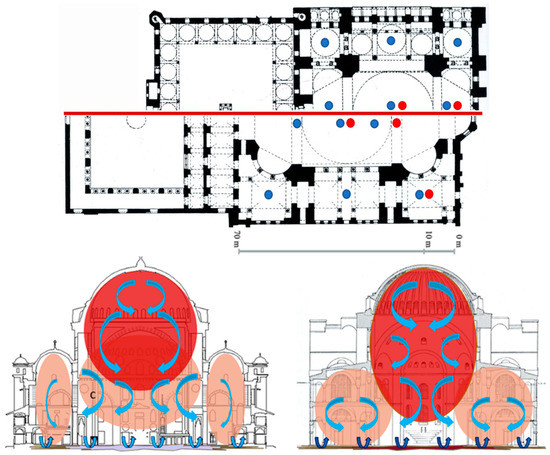
Figure 16.
Above: partial plans of Süleymaniye Mosque (above) and Hagia Sophia (below); below: conceptual section view of sound energy flows of Süleymaniye Mosque (on the left) and Hagia Sophia (on the right).
6. Conclusions
Within the context of this study, sound fields of two sacred multi-domed historical structures, namely Hagia Sophia and Süleymaniye Mosque, are analyzed with a focus on their architectonic and material attributes, and applied alterations in basic restoration works. The historical significance of the monuments attracted the attention of different research groups, ending up with extensive data in the literature both in acoustics and also in many other fields such as structure, material science, restoration, or art history. A comprehensive study on the acoustics of these sacred spaces is necessitated, by a comparative analysis over acoustical field tests held in different years and over wide-ranging literature on their material and architectural features. The methodology included the field tests carried both within the scope of this research as well as the previously published test results by other researchers. Acoustical simulations were utilized for comparison of unoccupied versus occupied conditions and also for discussion on original materials.
The major difference in between the two monuments is that Hagia Sophia was originally designed to function as a church, while Süleymaniye is a mosque. The basillican layout of Hagia Sophia in comparison to the square and central plan of Süleymaniye Mosque resulted in volumetric differences. Both structures have a highly reflective upper structure, with stone and plaster claddings, while also have many sound scattering elements as of muqarnases or stalactites and space dividing arches. Another major difference in effect of acoustics is that Süleymaniye Mosque has a carpet floor finish whereas Hagia Sophia has a marble floor cladding.
The major acoustical outcomes of this study can be summarized as below:
- Having a larger volume (almost double) and reflective floor finish, Hagia Sophia resulted in higher reverberation times in comparison to Süleymaniye Mosque in mid to high frequencies. This result is appropriate for the original function of Hagia Sophia considering the liturgical music held in churches and cathedrals, in comparison to mosques where liturgical music is seldom.
- In lower octave bands, Süleymaniye Mosque has greater reverberation values in comparison to Hagia Sophia. The excessive reverberation in low frequencies of Süleymaniye Mosque is discussed for its original state by a trial on applying historical lime-based plasters through simulations. Inherently good sound absorption characteristics of historical multi-layered lime-based plasters have resulted in much proper acoustical parameter results within Süleymaniye Mosque.
- Due to the effective surface area, the slight difference on the plasters′ sound absorption performance significantly changes the overall acoustical character of sacred spaces. Thus, the physical and chemical characteristics of plasters used in restorations and renovations are highly important, not only for other building physics aspects, but as well for acoustics science.
- The high reverberance of such mega-structures may negatively affect speech intelligibility due to its masking effect. However, a very short reverberation rating would cause a dry acoustical environment and reduce the envelopment and spaciousness in a religious space. Thus, the optimization studies of reverberation times in sacred spaces should not disregard the spiritual aspects.
- The recent restoration work on Süleymaniye Mosque when compared to previous years′ field test results has ended up in lower and much more optimal reverberation times in mid to high frequencies, on average. This is most probably due to the removal of cement-based plasters, but is still not totally effective. However, the low frequencies are even higher. One reason for lower decay rates of previous field tests in low frequencies is thought to be due to the insufficient impulse response length.
- A concave dome is a representation of the wholly world, while at the same time this geometry is the primary reason for sound focusing and all relevant acoustical defects as of echoesBurnt-clay pots (Sebu′s) as discussed in Süleymaniye Mosque, might had cured the low frequency sound energy built-up within the Mosque, as well as provided acoustical asymmetry in overcoming acoustical defects as of sound foci or echo formation. This approach should be a motivation for today′s scientific research with much developed acoustical technology.
- On the other hand, the particular geometrical configuration of multi-domed case structures and interrupted plan-layout with arches, and elements such as mahfili′s, elephant feet′s, columns, and piers, help to overcome fluttering echoes in between parallel wall surfaces and also help an even distribution of sound.
- All of the field tests in Hagia Sophia were held after the major architectural revisions in relation to the function of this sacred space. The most recent field tests held within the scope of this research indicates that the reverberation times in overall frequency spectrum is lowered by 1–2 s.
- Another discussion point, briefly mentioned in this study, is that the sacred monuments provide not a single decay with a single reverberation time but multiple sound energy decays, which is rarely observed in modest sized single-space structures. The significance of multiple-decay, in form of early and late energy, is that the early decay enhances clarity or definition of sound, while the late decay contributes to the reverberance that complements spiritual needs.
To conclude, the comparative analyses as done in this research are beneficial for acquiring insight to the acoustical outcomes of repairs and restorations. However, the discussion on the basic acoustical metrics that have been studied for years on historical sacred mega-structure is a challenge, especially for the cases where there are multiple-sound energy decays. It should be noted that the unusual sensation (hearing) of sound in such monumental sacred spaces may be explained by overlapping decay curves and their acoustical outcomes, which also might have contributed to them being called out as the world′s significant architectural master-pieces, for both the selected case studies as well as the other sacred edifices of the world.
Acknowledgments
The author would like to express her gratitude for the given permissions by General Directorate of Pious Foundations for Süleymaniye Mosque field tests, and to Turkish Ministry of Culture and Tourism, and General Directorate of Turkish Cultural Heritage and Museums for Hagia Sophia field tests. Mehmet Çalışkan, Ayşe Tavukçuoğlu and Ning Xiang are gratefully acknowledged for their guiding and support during different phases of this research.
Conflicts of Interest
The authors declare no conflict of interest.
References
- Abdelazeez, M.K.; Hammad, R.N.; Mustafa, A.A. Acoustics of King Abdullah Mosque. J. Acoust. Soc. Am. 1991, 90, 1441–1445. [Google Scholar] [CrossRef]
- Suárez, R.; Alonso, A.; Sendra, J.J. Virtual acoustic environment reconstruction of the hypostyle mosque of Cordoba. App. Acoust. 2018, 140, 214–224. [Google Scholar] [CrossRef]
- CAHRISMA, Conservation of the Acoustical Heritage by the Revival and Identification of Sinan′s Mosques′ Acoustics; Project report No: ICA3-CT-1999-00007, Work package 2, Deliverables; Yıldız Technical University: Istanbul, Turkey.
- Abdou, A.A. Measurement of acoustical characteristics of mosques in Saudi Arabia. J. Acoust. Soc. Am. 2003, 113, 1505–1517. [Google Scholar] [CrossRef] [PubMed]
- Sü, Z.; Yılmazer, S. The acoustical characteristics of the Kocatepe Mosque in Ankara, Turkey. Arch. Sci. Rev. 2008, 51, 21–30. [Google Scholar] [CrossRef]
- Gül, Z.S.; Çalışkan, M. Impact of design decisions on acoustical comfort parameters: case study of Doğramacızade Ali Paşa Mosque. Technical Note. App. Acoust. 2013, 74, 834–844. [Google Scholar] [CrossRef]
- Magrini, A.; Magnani, L. Models of the influence of coupled spaces in Christian churches. Build. Acoust. 2005, 12, 115–139. [Google Scholar] [CrossRef]
- Luigi, E.; Martellotta, F. Acoustics as a cultural heritage: the case of Orthodox churches and of the “Russian church” in Bari. J. Cult. Heritage 2015, 16, 912–917. [Google Scholar]
- Martellotta, F. Identifying acoustical coupling by measurements and prediction-models for St. Peter′s Basilica in Rome. J. Acoust. Soc. Am. 2009, 126, 1175–1186. [Google Scholar] [CrossRef]
- Anderson, J.S.; Anderson, M.B. Acoustic coupling effects in St Paul’s Cathedral, London. J. Sound Vib. 2000, 236, 209–225. [Google Scholar] [CrossRef]
- Alonso, A.; Suárez, R.; Sendra, J.J. On the assessment of the multiplicity of spaces in the acoustic environment of cathedrals: The case of the cathedral of Seville. App. Acoust. 2018, 141, 54–63. [Google Scholar] [CrossRef]
- Suárez, R.; Alonso, A.; Sendra, J.J. Intangible cultural heritage: the sound of the Romanesque Cathedral of Santiago de Compostela. J. Cult. Heritage 2015, 16, 239–243. [Google Scholar] [CrossRef]
- Pedrero, A.; Ruiz, R.; Díaz-Chyla, A.; Díaz, C. Acoustical study of Toledo Cathedral according to its liturgical uses. App. Acoust. 2014, 85, 3–33. [Google Scholar] [CrossRef]
- Kleiner, M.; Klepper, D.L.; Torres, R.R. Worship Space Acoustics, 1st ed.; J. Ross Publishing: Plantation, FL, USA, 2010; pp. 227–271. [Google Scholar]
- Sü Gül, Z.; Xiang, N.; Çalışkan, M. Investigations on sound energy decays and flows in a monumental mosque. J. Acoust. Soc. Am. 2016, 140, 344–355. [Google Scholar] [CrossRef] [PubMed]
- SüGül, Z. Assessment of Non-Exponential Sound Energy Decays within Multi-Domed Monuments by Numerical and Experimental Methods. Ph.D. Thesis, Middle East Technical University (METU), Ankara, Turkey, January 2015. [Google Scholar]
- Sü Gül, Z.; Çalışkan, M.; Tavukcuoglu, A.; Xiang, N. Assessment of acoustical indicators in multi-domed historic structures by non-exponential energy decay analysis. Acoust. Aust. 2018, 46, 181–192. [Google Scholar] [CrossRef]
- Klenbauer, W.E.; White, A.; Matthews, H. Hagia Sophia; Scala Publishers: London, UK, 2004. [Google Scholar]
- Oyhon, E.; Etingü, B. Hagia Sophia, Church of Divine Wisdom. In Churches in İstanbul; YKY: Istanbul, Turkey, 1999. [Google Scholar]
- Mark, R.; Çakmak, A.S. Hagia Sophia from the age of Justinian to the Present; Cambridge University Press: New York, NY, USA, 1992. [Google Scholar]
- Kahler, H.; Mango, C. Hagia Sophia; Frederick A. Praeger: New York, NY, USA, 1967. [Google Scholar]
- Mainstone, R.J. Hagia Sophia: Architecture, structure and liturgy of Justinian′s Great Church; Thames and Hudson: London, UK, 1988. [Google Scholar]
- Weitze, C.A.; Rindel, J.H.; Christensen, C.L.; Gade, A.C. The Acoustical History of Hagia Sophia Revived through Computer Simulation; Forum Acusticum: Seville, Spain, 2002. [Google Scholar]
- Abel, J.S.; Woszczyk, W.; Ko, D.; Levine, S.; Hong, J.; Skare, T.; Wilson, M.J.; Coffin, S.; Lopez-Lezcano, F. Recreation of the Acoustics of Hagia Sophia in Stanford′s Bing Concert Hall for the Concert Performance and Recording of Cappella Romana. In Proceedings of the International Symposium on Room Acoustics, Toronto, ON, Canada, 9–11 June 2013. [Google Scholar]
- Akgündüz, A.; Öztürk, S.; Baş, Y. Kiliseden Müzeye Ayasofya; Osmanlı Araştırmaları Vakfı: Fatih/İstanbul, Turkey, 2006; pp. 174–180, 280–285. [Google Scholar]
- Eyice, S. Ayasofya; Yapı Kredi: Istanbul, Turkey, 1984. [Google Scholar]
- Cantay, T. Süleymaniye Camii; EREN Yayıncılık: Istanbul, Turkey, 1989. [Google Scholar]
- T.R. Prime Ministry Directorate General of Foundations Archive. 2011.
- Saatçi, S. Temelden Aleme İnşaat Süreci. In Bir Şaheser Süleymaniye Külliyesi; Mülayim, S., Ankara, T.C., Eds.; Kültür ve Turizm Bakanlığı: Ankara, Turkey, 2007; pp. 57–74. [Google Scholar]
- Yılmaz, Y. Kanuni Vakfiyesi Süleymaniye Külliyesi; Vakıflar Genel Müdürlüğü: Ankara, Turkey, 2008; pp. 87–134. [Google Scholar]
- Necipoğlu-Kafadar, G. The Süleymaniye Complex in İstanbul: an interpretation. Muqarnas 1985, 3, 92–117. [Google Scholar] [CrossRef]
- Mungan, I. Strüktür Çözümü. In Bir Şaheser Süleymaniye Külliyesi; Mülayim, S., Ankara, T.C., Eds.; Kültür ve Turizm Bakanlığı: Ankara, Turkey, 2007. [Google Scholar]
- Kuban, D.A. Symbol of ottoman architecture: The Süleymaniye. In Ottoman Architecture; Antique Collectors′ Club: Suffolk, UK, 2010; pp. 277–294. [Google Scholar]
- Kolay, I.A.; Çelik, S. Ottoman stone acquisition in the mid-sixteenth century: The Süleymaniye Complex in Istanbul. Muqarnas 2006, 23, 251–272. [Google Scholar] [CrossRef]
- Barkan, L.O. Süleymaniye Camii ve İmareti İnşaatı (1550-1557); Türk Tarih Kurumu Matbaası: Ankara, Turkey, 1972; Volume 1, pp. 14–45. [Google Scholar]
- Eyüpgiller, K. Restitüsyon ve Renovasyon. In Bir Şaheser Süleymaniye Külliyesi. Mülayim. Mülayim, S.; Mülayim, S., Ankara, T.C., Eds.; Kültür ve Turizm Bakanlığı: Ankara, Turkey, 2007; pp. 193–232. [Google Scholar]
- İrteş, S. Kalemişi, Cam ve Revzen. In Bir Şaheser Süleymaniye Külliyesi. Mülayim. Mülayim, S.; Mülayim, S., Ankara, T.C., Eds.; Kültür ve Turizm Bakanlığı: Ankara, Turkey, 2007; pp. 293–328. [Google Scholar]
- Ersen, A.; Nilgün, O.; Akbulut, S.S.; Yıldırım, B.S. Süleymaniye Camii 2007–2010 yılları restorasyonu ve restorasyon kararları. Restorasyon 2011, 3, 6–27. [Google Scholar]
- Acar, S. Süleymaniye′nin düşündürdükleri. Tasarım 2000, 102, 108–117. [Google Scholar]
- A Discussion on the Acoustics of Süleymaniye Mosque for its Original State. Available online: http://www.radikal.com.tr/turkiye/256_bos_kupun_sirri-1028387 (accessed on 17 July 2013).
- ISO 3382-1. Acoustics-Measurement of Reverberation Time of Rooms with Reference to Other Acoustical Parameters; ISO: Geneva, Switzerland, 2009. [Google Scholar]
- Sü Gül, Z.; Çalışkan, M.; Tavukcuoglu, A. On the acoustics of Süleymaniye Mosque from past to present. Megaron 2014, 9, 201–216. [Google Scholar] [CrossRef]
- Kayılı, M. Mimar Sinan′ın Camilerindeki Akustik Verilerin Değerlendirilmesi. Mimarbaşı Koca Sinan: Yaşadığı Çağ ve Eserleri. 1988, 1, 545–555. [Google Scholar]
- Topaktaş, L. Acoustical properties of classical ottoman mosques, simulation and measurements. Master’s Thesis, Middle East Technical University (METU), Ankara, Turkey, July 2003. [Google Scholar]
- Naylor, G.M. ODEON—another hybrid room acoustical model. Appl. Acoust. 1993, 38, 131–143. [Google Scholar] [CrossRef]
- Sü Gül, Z.; Xiang, N.; Çalışkan, M. Diffusion equation based finite element modeling of a monumental worship space. J. Comput. Acoust. 2017, 25, 1–16. [Google Scholar]
- Sü Gül, Z.; Odabaş, E.; Xiang, N.; Çalışkan, M. Diffusion equation modeling for sound energy flow analysis in multi domain structures. J. Acoust. Soc. Am. 2019, 145, 2703–2717. [Google Scholar] [CrossRef] [PubMed]
- Ahnert, W.; Feistal, S.; Behrens, T. Speech Intelligibility Prediction in very Large Sacral Venues. In Proceedings of the Meetings on Acoustics ICA2013, Montreal, QC, Canada, 2–7 June 2013. [Google Scholar]
- Tavukçuoğlu, A.; Aydın, A.; Çalışkan, M. Tarihi Türk Hamamlarının Akustik Nitelikleri: Özgün Hali ve Bugünkü Durumu. In Proceedings of the TAKDER 9th National Congress, Ankara, Turkey, 26–27 May 2011. [Google Scholar]
- SüGül, Z.; Çalışkan, M. Acoustical Design of Turkish Religious Affairs Mosque. In Proceedings of the 21st International Congress on Acoustics ICA2013, Montreal, QC, Canada, 2–7 June 2013. [Google Scholar]
- ASHRAE Handbook HVAC Applications, SI ed.; American Society of Heating, Refrigerating, and Air Conditioning Engineers: Atlanta, GA, USA, 2011.
- SüGül, Z.; Tavukcuoglu, A.; Çalışkan, M.A. Discussion on the Acoustics of Süleymaniye Mosque for its Original State. In Proceedings of the 9th International Symposium on the Conservation of Monuments in the Mediterranean Basin (MONUBASIN), Ankara, Turkey, 3–5 June 2014. [Google Scholar]
- Bos, H.L.; Van Den Oever, M.J.A.; Peters, O.C.J.J. Tensile and compressive properties of flax fibres for natural fibre reinforced composites. J. Mater. Sci. 2002, 37, 1683–1692. [Google Scholar] [CrossRef]
- Dalmay, P.; Smith, A.; Chotard, T.; Sahay-Turner, P.; Gloaguen, V.; Krausz, P. Properties of cellulosic fibre reinforced plaster: Influence of hemp or flax fibres on the properties of set gypsum. J. Mater. Sci. 2010, 45, 793–803. [Google Scholar] [CrossRef]
- Orfali, W.A. Sound Parameters in Mosques. In Proceedings of the 153rd Meeting of ASA, Salt Lake City, UT, USA, 4–8 June 2007. [Google Scholar]
© 2019 by the author. Licensee MDPI, Basel, Switzerland. This article is an open access article distributed under the terms and conditions of the Creative Commons Attribution (CC BY) license (http://creativecommons.org/licenses/by/4.0/).